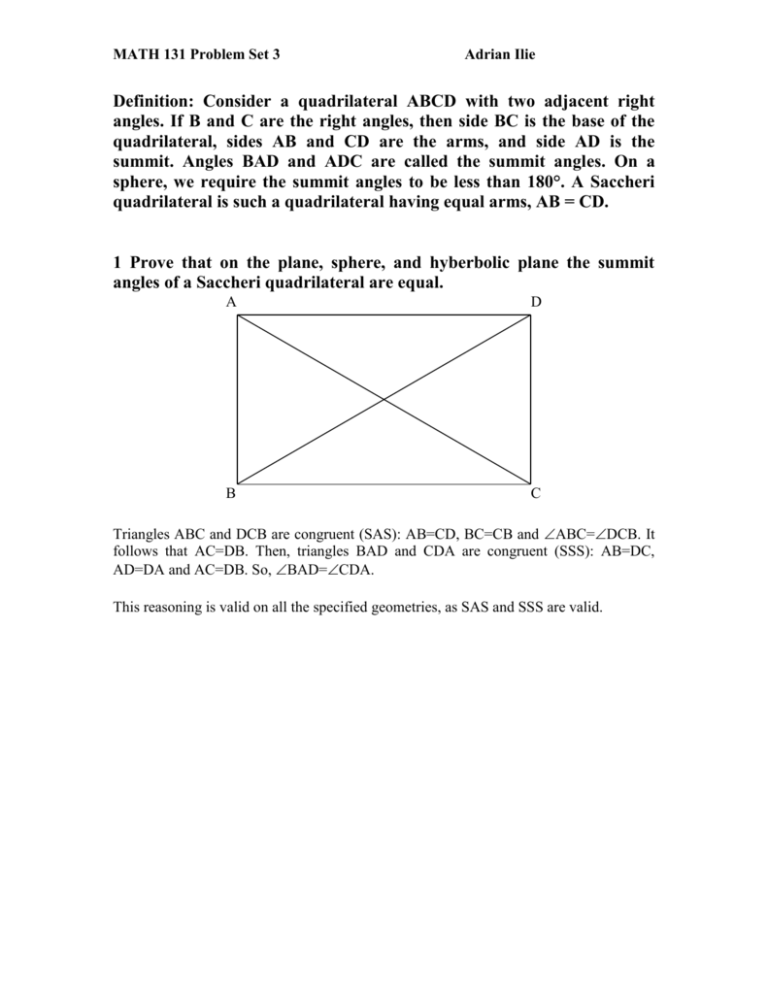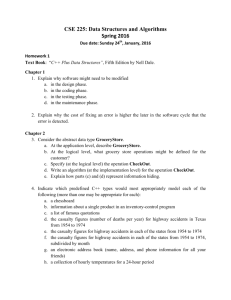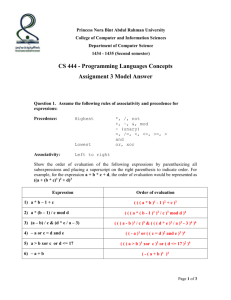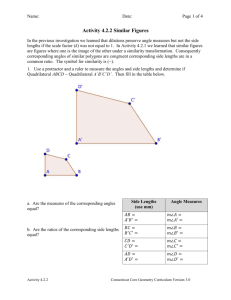MATH 131 Problem Set 3
advertisement

MATH 131 Problem Set 3 Adrian Ilie Definition: Consider a quadrilateral ABCD with two adjacent right angles. If B and C are the right angles, then side BC is the base of the quadrilateral, sides AB and CD are the arms, and side AD is the summit. Angles BAD and ADC are called the summit angles. On a sphere, we require the summit angles to be less than 180°. A Saccheri quadrilateral is such a quadrilateral having equal arms, AB = CD. 1 Prove that on the plane, sphere, and hyberbolic plane the summit angles of a Saccheri quadrilateral are equal. A D B C Triangles ABC and DCB are congruent (SAS): AB=CD, BC=CB and ABC=DCB. It follows that AC=DB. Then, triangles BAD and CDA are congruent (SSS): AB=DC, AD=DA and AC=DB. So, BAD=CDA. This reasoning is valid on all the specified geometries, as SAS and SSS are valid. MATH 131 Problem Set 3 Adrian Ilie 2 Given a Saccheri quadrilateral ABCD having base BC, let E be the midpoint of the base and let F be the midpoint of the summit. Prove that EF (sometimes called the midline of the quadrilateral) is perpendicular to both the summit and the base. A F D B E C Triangles ABE and DCE are congruent (SAS): AB=DC, BE=EC and ABE=DCE. It follows that AE=DE. Then, triangles AFE and DFE are congruent (SSS): AF=FD, FE=EF and AE=DE. It follows that AFE=DFE. Since AFE+DFE=180 degrees, AFE=BFE=90 degrees. Triangles BAF and CDF are congruent (SAS): AB=DC, AF=FD and BAF=CDF. It follows that BF=FC. Then, triangles BEF and CEF are congruent (SSS): BF=CF, FE=EF and BE=EC. It follows that BEF=CEF. Since BEF+CEF=180 degrees, BEF=CEF=90 degrees. This reasoning is valid on all the specified geometries, as SAS and SSS are valid, and angle measurements are additive. MATH 131 Problem Set 3 Adrian Ilie 3 Show that the summit angles of a Saccheri quadrilateral are right angles on the plane, obtuse angles on the sphere, and acute angles on the hyperbolic plane. We have: BAE=sum1-ABE-BEA EAF=sum2-AFE-AEF Here sumi is the sum of the angles in a triangle. Adding the two equalities, we get: BAE+EAF=(sum1-ABE-BEA)+(sum2-AFE-AEF)=sum1+sum2-90-90(BEA+AEF)= sum1+sum2-180-BEF= sum1+sum2-180-90= sum1+sum2-270 But BAE+EAF=BAF. So, BAF=sum1+sum2-270 In the plane, sum1=sum2=180, so BAF=sum1+sum2-270=2*180-270=90, BAF is a right angle. On the sphere, sum1>180 and sum1>180, so BAF=sum1+sum2-270>2*180-270=90, BAF is an obtuse angle. On the hyperbolic plane, sum1<180 and sum2<180, so BAF=sum1+sum2-270<2*180270=90, BAF is an acute angle. Using a similar reasoning, we have: CDE=sum-DCE-CED EDF=sum-DFE-DEF Here sum is the sum of the angles in a triangle. Adding the two equalities, we get: CDE+EDF=(sum1-DCE-CED)+(sum2-DFE-DEF)=sum1+sum2-90-90(CED+DEF)= sum1+sum2-180-BEF= sum1+sum2-180-90= sum1+sum2-270 But CDE+EDF=CDF. So, CDF=sum1+sum2-270 In the plane, sum1=sum2=180, so CDF= sum1+sum2-270=2*180-270=90, CDF is a right angle. On the sphere, sum1>180 and sum1>180, so CDF=sum1+sum2-270>2*180-270=90, CDF is an obtuse angle. On the hyperbolic plane, sum1<180 and sum2<180, so CDF=sum1+sum2-270<2*180270=90, CDF is an acute angle.









